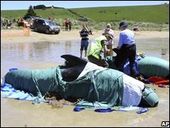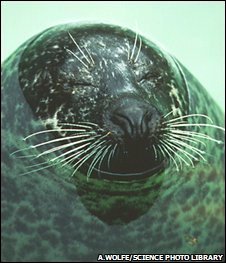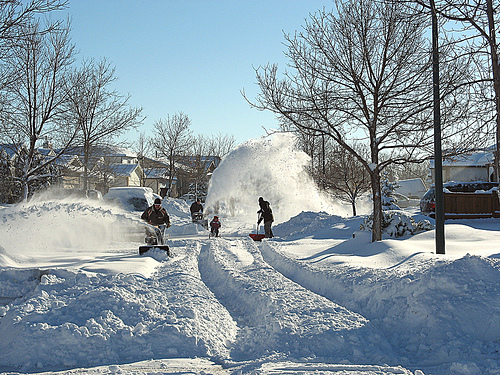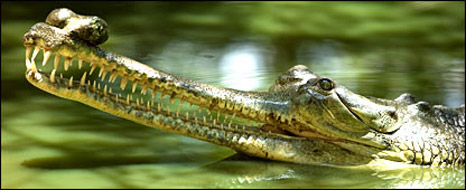Increasing noise pollution in the world's oceans is threatening the survival of whales 
Some whales show damage suggesting they surfaced too quickly, experts say
Experts say the noises sea creatures use to communicate are being drowned out by noises from commercial shipping, new military sonar and climate change.
They become disoriented, cannot find mates or food and behave differently, scientists say.
James Morgan
BBCSun, 07 Dec 2008 19:39 UTC
Harbour seals, or common seals, are familiar faces along coastlines across 
Drowning, not waving - harbour seal numbers have halved in some areas
But they are now vanishing in the UK at an alarming rate, warn scientists from St Andrews University.
Numbers have halved in the hardest hit area, the Orkney Islands, since 2001 - falling almost 10% each year.
A new sub-population of a Critically Endangered species of monkey has been recorded in north-western Vietnam.
Biologists from Fauna and Flora International said they had found up to 20 Tonkin snub-nosed monkeys in a remote forest.
The team said the new group offered a ray of hope because it included three infants, suggesting that the monkeys were breeding and increasing in number.
Have you noticed that we describe the market and economy as if they were living entities? The market is showing signs of stress. The economy is healthy. The economy is on life support.
Sometimes, we act as if the economy is larger than life. In the past, people trembled in fear of dragons, demons, gods, and monsters, sacrificing anything - virgins, money, newborn babies - to appease them. We know now that those fears were superstitious imaginings, but we have replaced them with a new behemoth: the economy.
Even stranger, economists believe this behemoth can grow forever. Indeed, the measure of how well a government or corporation is doing is its record of economic growth. But our home - the biosphere, or zone of air, water, and land where all life exists - is finite and fixed. It can't grow. And nothing within such a world can grow indefinitely. In focusing on constant growth, we fail to ask the important questions. What is an economy for? Am I happier with all this stuff? How much is enough?
Comment: The 'brain damage" is more correctly defined as pyschopathy. Psychopaths have no sense of long-term consequences. They're hard-wired to pay attention only to their own desires and goals, without considering the wider ramifications of those goals.

© unknownWinter in Winnipeg
Will we freeze in our boots or skate through a mild winter?
Weather forecasters say parts of Manitoba might be in store for cooler than normal temperatures from now through February with more precipitation than usual this winter.
"
We're saying this will be a colder than normal year," said David Phillips, senior climatologist for Environment Canada.
The weather agency doesn't predict exactly how much colder the winter might be but Phillips said it could be similar to last winter, which ran about one degree colder than normal.

© UnknownSome gharials may be feeding on fish that have large toxic loads
Just 100 years ago, these fish-eating reptiles were prevalent throughout the Indian subcontinent; but by 2007, there were just 200 breeding adults found in only a handful of rivers in India and Nepal.
Last winter, this already critically endangered species was dealt another cruel blow. Over the space of just five months, more than 100 of the creatures washed up dead on the banks of India's Chambal river - and nobody knew why.
For the past year, herpetologist Rom Whitaker, who runs the Madras Crocodile Bank, has been followed by a BBC Natural World team as he attempted to solve this mystery.
In 1980, scientists Luis Alvarez and his son, Walter, proposed a new explanation for the dinosaurs' disappearance 65 million years ago: a meteor strike. Initially, the idea was met with resistance. But the evidence was convincing: a sediment layer high in iridium, an element common in asteroids, was found the world over, along with a 110-mile-wide impact crater in the Yucatán of the same age. What started as a fringe idea has gone mainstream.
Now scientists are rethinking another of earth's great die-offs. The end-Permian extinction 251 million years ago was the worst of earth's five mass extinctions. Ninety percent of all marine life and 70 percent of terrestrial life disappeared. It took five million years, perhaps more, for the biosphere to recover.
But while the die-off was uniquely devastating, evidence of a single cataclysmic event, like an asteroid strike, hasn't been found in the geological record. Scientists now suspect that "the mother of all mass extinctions" was of Earth's own making. And the more they learn about it, the more parallels they see to today's world: A bout of greenhouse-gas-induced global warming, much like today's, set off a chain of events that culminated in oxygen-depleted oceans exhaling poison gas.
Comment: Notice the tactic of linking some good science with the subtle reassurance that "the asteroids (or comets) are not to blame". Besides "who sez" that the oceans can't become anoxic in conditions of global cooling?
A new atlas shows how conservation efforts can most efficiently make use of limited resources by laying out which forests store large amounts of carbon and are also home to a great diversity of animals and plants.
The UN Environment Programme, which released the
maps at the ongoing
UN climate summit in Poznan, Poland, believes they could guide investments in forest conservation.
"At a time of scarce financial resources and economic concerns, every dollar, euro or rupee needs to deliver double, even triple dividends," says Achim Steiner, executive director of UNEP. "By pinpointing where high densities of carbon overlap with high levels of biodiversity, the atlas spotlights where governments and investors can deal with two crises for the price of one."
The lack of policies against indiscriminate deforestation in river basins, in synergy with the rainy season, which is heavier than usual this year because of the La Niña climate phenomenon, has had devastating effects in Colombia.
This "winter," as the rainy season is called in this country, there have already been 600 local disasters caused by gale-force winds and constant, heavy rainfall. Rivers have burst their banks, and landslides and avalanches of all kinds have occurred, meteorologist Max Henríquez told IPS.
The rains began in September and will probably only let up in mid-December, because of La Niña. "Throughout 2007 and for several months this year we have experienced this climate phenomenon, caused by the cooling of the surface waters in the Pacific ocean, which brings above normal rainfall," the meteorologist said.
A report shows that torrential rain, not a dam malfunction, caused the flooding in June that affected one of every seven structures in Columbus, Indiana.
A report from the U.S. Geological Survey summarized reasons for the event, detailed its effects and illustrated its severity with maps, charts and rainfall data. City Engineer Steve Ruble says the study eliminates the possibility of a "smoking gun'' and proves the flooding came from rainfall on June 6 and 7.
Comment: The 'brain damage" is more correctly defined as pyschopathy. Psychopaths have no sense of long-term consequences. They're hard-wired to pay attention only to their own desires and goals, without considering the wider ramifications of those goals.